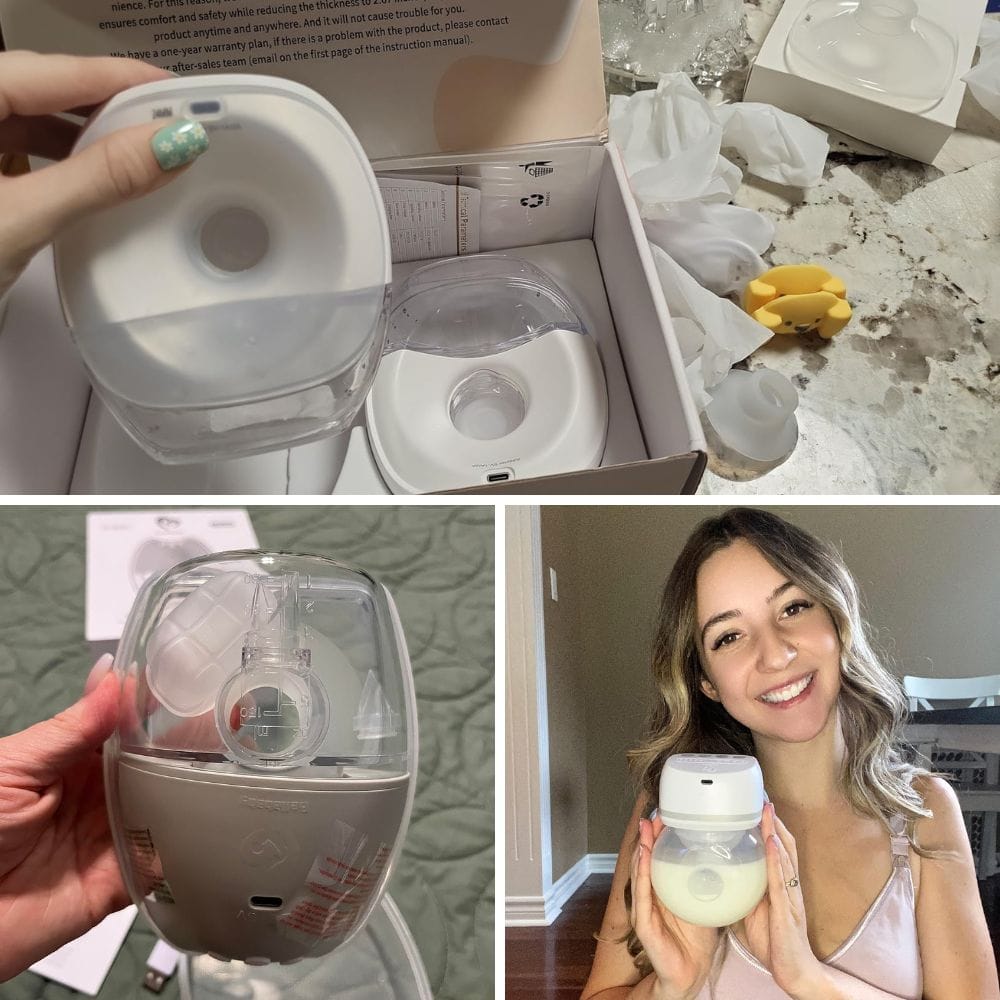Key Takeaways:
- Understanding the Basics: Learn the fundamental components and functions of a wearable breast pump.
- Effective Usage Tips: Discover practical advice for maximizing milk supply and ensuring comfortable pumping sessions.
- Maintenance and Troubleshooting: Gain insights into maintaining your pump and addressing common issues.
Introduction to Wearable Breast Pumps
Wearable breast pumps have revolutionized the way new moms manage breastfeeding and pumping. Unlike traditional pumps, these devices offer the convenience of hands-free operation, allowing mothers to multitask while expressing milk. This article will guide you through the essentials of using a wearable breast pump, ensuring you get the most out of your pumping sessions.
Understanding Wearable Breast Pumps
Wearable breast pumps are designed to fit inside your bra, making them discreet and portable. They typically consist of a motor, breast shields, and milk collection cups. The motor powers the pump, while the breast shields create a seal around your nipples to facilitate milk flow. The milk is collected in the cups, which can be easily removed and emptied.
These pumps are battery-operated, with many models featuring a battery indicator light to alert you when it's time to recharge. Some advanced models even offer app connectivity, allowing you to monitor your pumping sessions and adjust settings from your smartphone.
Choosing the Right Wearable Breast Pump



When choosing a wearable breast pump, take into account factors such as suction power, battery life, and ease of use. Look for a pump with adjustable suction settings to ensure comfortable pumping. A long battery life is essential for moms on the go, while a user-friendly design can make the pumping process more straightforward.
It's also important to choose a pump that fits well with your body. Ensure the breast shields are the right size for your nipples to prevent discomfort and maximize milk flow. Some pumps come with multiple flange sizes, allowing you to find the perfect fit.
Preparing for Your First Pumping Session

Before you start pumping, make sure your pump is fully charged. Assemble the pump parts according to the manufacturer's instructions, ensuring all components are clean and dry. Slip the pump into your nursing bra, making sure the breast shields are centered over your nipples.
Turn on the pump and select the stimulation mode to encourage milk letdown. This mode mimics your baby's initial sucking pattern, helping to stimulate milk flow. Once you see milk starting to flow, switch to the expression mode to continue pumping.
Finding the Right Pump Settings
Adjusting the pump settings is crucial for a comfortable and efficient pumping session. Start with a low suction strength and gradually increase it until you find a level that is effective yet comfortable. Avoid setting the suction too high, as this can cause nipple pain and damage.
Experiment with different modes and settings to find what works best for you. Some pumps offer a massage mode to help stimulate milk flow, while others have a double pump feature for expressing milk from both breasts simultaneously. Keep track of your preferred settings for future sessions.
Ensuring Comfortable Pumping
Comfort is key when using a wearable breast pump. Make sure the breast shields fit properly and create a good seal around your nipples. If you experience discomfort, try adjusting the position of the pump or switching to a different flange size.
Wearing a supportive nursing bra can also enhance comfort. Look for a bra that holds the pump securely in place without putting too much pressure on your breasts. Some moms find it helpful to use a pumping bra specifically designed for hands-free pumping.
Maximizing Milk Supply
To maximize your milk supply, aim to pump regularly and consistently. Try to mimic your baby's feeding schedule, pumping every 2-3 hours during the day. This helps to maintain your milk production and ensures you have enough expressed milk for your baby.
Stay hydrated and maintain a balanced diet to support your milk supply. Some moms find that certain foods and supplements, such as oats and fenugreek, can help boost milk production. Consult with a lactation consultant if you have concerns about your milk supply.
Cleaning and Maintaining Your Pump
Proper cleaning and maintenance are essential for the longevity of your wearable breast pump. After each use disassemble the pump parts and wash them thoroughly with warm, soapy water. Some parts may be dishwasher-safe, but always check the manufacturer's instructions.
Regularly inspect the pump for any signs of wear and tear. Replace any damaged or worn-out parts to ensure the pump continues to function effectively. Keep the motor and battery compartment clean and dry to prevent damage.
Troubleshooting Common Issues
If you encounter issues with your wearable breast pump, there are several steps you can take to troubleshoot. If the pump isn't turning on, check the battery indicator light and ensure the pump is fully charged. If the suction seems weak, make sure all parts are assembled correctly and there are no leaks.
If you experience discomfort or pain while pumping, try adjusting the suction settings or switching to a different flange size. If problems persist, consult the manufacturer's troubleshooting guide or contact customer support for assistance.
Storing and Handling Expressed Milk
Proper storage and handling of expressed milk are crucial for your baby's health. Store milk in clean, BPA-free containers or breast milk storage bags. Label each container with the date and time of expression to keep track of freshness.
Refrigerate or freeze the milk immediately after pumping. Freshly expressed milk can be stored in the refrigerator for up to 4 days, or in the freezer for up to 6 months. Thaw frozen milk in the refrigerator or by placing the container in warm water. Never microwave breast milk, as this can destroy valuable nutrients.
Using a Wearable Pump on the Go
One of the main advantages of wearable breast pumps is their portability. These pumps allow you to express milk discreetly while on the go, whether you're at work, running errands, or traveling. Make sure to carry spare pump parts, a charger, and storage bags for expressed milk.
Plan your pumping sessions around your schedule to ensure you have enough time to pump and store the milk properly. Find a private and comfortable space to pump, and use a nursing cover if you prefer more privacy.
Integrating Pumping into Your Routine
Integrating pumping into your daily routine can be challenging, especially for new moms. Establish a pumping schedule that works for you and stick to it as much as possible. Consistency is crucial for maintaining your milk supply and ensuring you have enough expressed milk for your baby.
Communicate with your employer about your pumping needs if you're returning to work. Many workplaces are required to provide a private space and reasonable break time for pumping. Having a supportive environment can make a significant difference in your pumping experience.
Benefits of Wearable Breast Pumps
Wearable breast pumps offer numerous benefits for breastfeeding moms. They provide the freedom to pump hands-free, allowing you to multitask and manage your daily activities more efficiently. These pumps are also discreet and portable, making it easier to pump on the go.
Additionally, wearable pumps can help maintain your milk supply by allowing you to pump more frequently and consistently. This is especially beneficial for moms who are exclusively pumping or returning to work.
Comparing Wearable and Traditional Pumps
While traditional pumps are effective, they can be bulky and require you to be stationary while pumping. Wearable pumps, on the other hand, offer greater flexibility and convenience. They are designed to fit inside your bra allowing you to pump discreetly and hands-free.
However, traditional pumps often have stronger suction power and may be more suitable for moms with specific pumping needs. Consider your lifestyle and pumping requirements when choosing between a wearable and a traditional pump.
Tips for New Moms
For new moms, using a wearable breast pump can be a learning curve. Start by familiarizing yourself with the pump's features and settings. Practice assembling and disassembling the pump parts to ensure you can do it quickly and efficiently.
Don't be discouraged if you don't get a lot of milk during your first few pumping sessions. It can take time for your body to adjust to the pump. Be patient and consistent, and consult with a lactation consultant if you have any concerns or questions.
Support and Resources
Having a support system can make a significant difference in your breastfeeding and pumping journey. Join online forums or local support groups to connect with other moms who are using wearable breast pumps. Sharing experiences and tips can be incredibly helpful.
Consult with a lactation consultant if you need personalized advice or support. They can help you troubleshoot issues, optimize your pumping sessions, and ensure you're using the pump correctly.


How often should I use a wearable breast pump?
It's recommended to pump every 2-3 hours during the day to maintain your milk supply. This frequency mimics your baby's feeding schedule and helps ensure you have enough expressed milk.
Can I use a wearable breast pump while working?
Yes, wearable breast pumps are designed for discreet and hands-free use, making them ideal for pumping at work. Communicate with your employer about your pumping needs and find a private space to pump.
How do I clean my wearable breast pump?
Disassemble the pump parts and thoroughly wash them with warm, soapy water after each use. Some parts may be dishwasher-safe, but always check the manufacturer's instructions. Regularly inspect and replace any damaged or worn-out parts.

Using a wearable breast pump can be a game-changer for breastfeeding moms. By understanding the basics, choosing the right pump, and following best practices, you can make the most of your pumping sessions and ensure a steady milk supply for your baby. Remember to maintain your pump, troubleshoot common issues, and seek support when needed.










